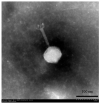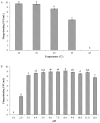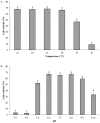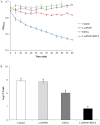Characterization of a Lytic Bacteriophage against Pseudomonas syringae pv. actinidiae and Its Endolysin
- PMID: 33917076
- PMCID: PMC8067700
- DOI: 10.3390/v13040631
Characterization of a Lytic Bacteriophage against Pseudomonas syringae pv. actinidiae and Its Endolysin
Abstract
Pseudomonas syringae pv. actinidiae (Psa) is a phytopathogen that causes canker in kiwifruit. Few conventional control methods are effective against this bacterium. Therefore, alternative approaches, such as phage therapy are warranted. In this study, a lytic bacteriophage (PN09) of Psa was isolated from surface water collected from a river in Hangzhou, China in 2019. Morphologically, PN09 was classified into the Myoviridae family, and could lyse all 29 Psa biovar 3 strains. The optimal temperature and pH ranges for PN09 activity were determined as 25 to 35 ∘C and 6.0 to 9.0, respectively. The complete genome of PN09 was found to be composed of a linear 99,229 bp double-stranded DNA genome with a GC content of 48.16%. The PN09 endolysin (LysPN09) was expressed in vitro and characterized. LysPN09 was predicted to belong to the Muraidase superfamily domain and showed lytic activity against the outer-membrane-permeabilized Psa strains. The lytic activity of LysPN09 was optimal over temperature and pH ranges of 25 to 40 ∘C and 6.0 to 8.0, respectively. When recombinant endolysin LysPN09 was combined with EDTA, Psa strains were effectively damaged. All these characteristics demonstrate that the phage PN09 and its endolysin, LysPN09, are potential candidates for biocontrol of Psa in the kiwifruit industry.
Keywords: Pseudomonas syringae pv. actinidiae; endolysin; kiwifruit; lytic bacteriophage; phage therapy.
Conflict of interest statement
The authors declare that the research was conducted in the absence of any commercial or financial relationships that could be construed as a potential conflict of interest.
Figures









Similar articles
-
Isolation and Characterization of Bacteriophages Against Pseudomonas syringae pv. actinidiae Causing Bacterial Canker Disease in Kiwifruit.J Microbiol Biotechnol. 2016 Feb;26(2):385-93. doi: 10.4014/jmb.1509.09012. J Microbiol Biotechnol. 2016. PMID: 26628254
-
Genome, Proteome and Structure of a T7-Like Bacteriophage of the Kiwifruit Canker Phytopathogen Pseudomonas syringae pv. actinidiae.Viruses. 2015 Jun 24;7(7):3361-79. doi: 10.3390/v7072776. Viruses. 2015. PMID: 26114474 Free PMC article.
-
Antibacterial synergy between a phage endolysin and citric acid against the Gram-negative kiwifruit pathogen Pseudomonas syringae pv. actinidiae.Appl Environ Microbiol. 2024 Mar 20;90(3):e0184623. doi: 10.1128/aem.01846-23. Epub 2024 Feb 6. Appl Environ Microbiol. 2024. PMID: 38319087 Free PMC article.
-
Advancements in the Use of Bacteriophages to Combat the Kiwifruit Canker Phytopathogen Pseudomonas syringae pv. actinidiae.Viruses. 2022 Dec 2;14(12):2704. doi: 10.3390/v14122704. Viruses. 2022. PMID: 36560706 Free PMC article. Review.
-
Kiwifruit bacterial canker: an integrative view focused on biocontrol strategies.Planta. 2021 Jan 27;253(2):49. doi: 10.1007/s00425-020-03549-1. Planta. 2021. PMID: 33502587 Review.
Cited by
-
Phage endolysins as new therapeutic options for multidrug resistant Staphylococcus aureus: an emerging antibiotic-free way to combat drug resistant infections.Front Cell Infect Microbiol. 2024 Jun 17;14:1397935. doi: 10.3389/fcimb.2024.1397935. eCollection 2024. Front Cell Infect Microbiol. 2024. PMID: 38953006 Free PMC article. No abstract available.
-
Current trends in management of bacterial pathogens infecting plants.Antonie Van Leeuwenhoek. 2023 Apr;116(4):303-326. doi: 10.1007/s10482-023-01809-0. Epub 2023 Jan 23. Antonie Van Leeuwenhoek. 2023. PMID: 36683073 Review.
-
Endolysins and membrane-active peptides: innovative engineering strategies against gram-negative bacteria.Front Microbiol. 2025 Jun 3;16:1603380. doi: 10.3389/fmicb.2025.1603380. eCollection 2025. Front Microbiol. 2025. PMID: 40529583 Free PMC article. Review.
-
A Single Catalytic Endolysin Domain Plychap001: Characterization and Application to Control Vibrio parahaemolyticus and Its Biofilm Directly.Foods. 2022 May 27;11(11):1578. doi: 10.3390/foods11111578. Foods. 2022. PMID: 35681328 Free PMC article.
-
LysGR1, a novel thermostable endolysin from Geobacillus stearothermophilus bacteriophage GR1.Front Microbiol. 2023 May 19;14:1178748. doi: 10.3389/fmicb.2023.1178748. eCollection 2023. Front Microbiol. 2023. PMID: 37275144 Free PMC article.
References
-
- Donati I., Cellini A., Buriani G., Mauri S., Kay C., Tacconi G., Spinelli F. Pathways of flower infection and pollen-mediated dispersion of Pseudomonas syringae pv. actinidiae, the causal agent of kiwifruit bacterial canker. Hortic. Res. 2018;5:1–13. doi: 10.1038/s41438-018-0058-6. - DOI - PMC - PubMed
-
- Koh Y., Jung J., Hur J. Current status of occurrence of major diseases on kiwifruits and their control in Korea. Acta Hortic. 2003;610:437–443. doi: 10.17660/ActaHortic.2003.610.58. - DOI
-
- Takikawa Y., Serizawa S., Ichikawa T., Tsuyumu S., Goto M. Pseudomonas syringae pv. actinidiae pv. nov.: The causal bacterium of canker of kiwifruit in Japan. JPN J. Phytopathol. 1989;55:437–444. doi: 10.3186/jjphytopath.55.437. - DOI
-
- Scortichini M. Occurrence of Pseudomonas syringae pv. actinidiae on kiwifruit in Italy. Plant Pathol. 1994;43:1035–1038. doi: 10.1111/j.1365-3059.1994.tb01654.x. - DOI
Publication types
MeSH terms
Substances
LinkOut - more resources
Full Text Sources
Other Literature Sources
Molecular Biology Databases
Research Materials
Miscellaneous

